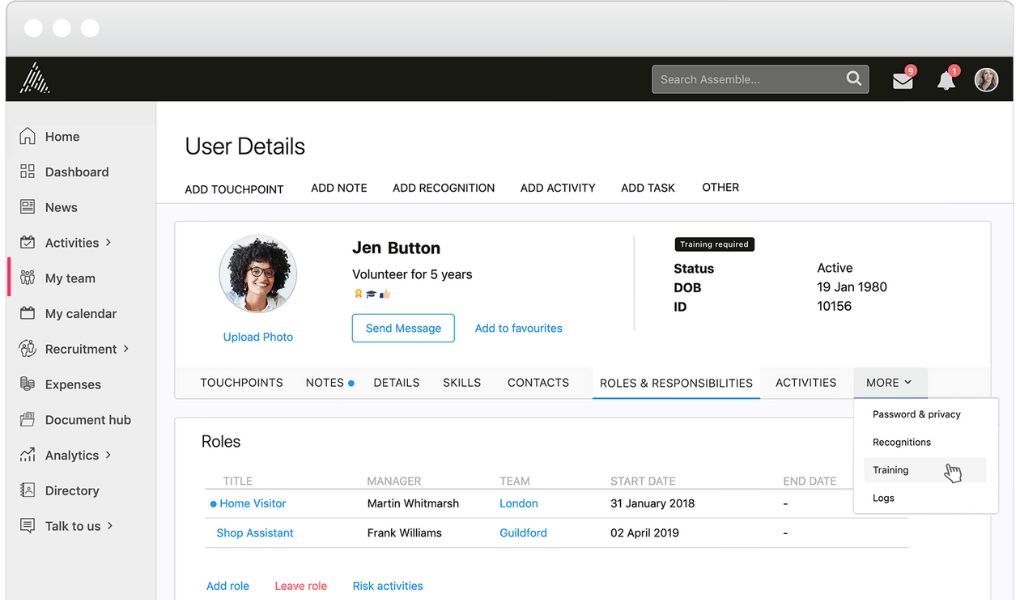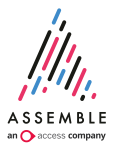How implementing volunteer management software (VMS) can enhance volunteer recruitment processes
Spotlight On: Dorothy House Hospice Care
In the first of our ‘Spotlight On’ series, Rachel Stewart, Head of Volunteering at Dorothy House, shares her experiences surrounding the impact that volunteer management software (VMS) can have on volunteer recruitment processes for hospices.
Rachel’s personal experience with our VMS, Assemble, provides an insight into the common volunteer recruitment challenges that the hospice faced and the key areas that the software helped to improve.

Dorothy House – who are we?
We’re a hospice that prides ourselves in providing exceptional, personalised end-of-life care to our patients for over 45 years. Recognised as being ‘Outstanding’ by the Care Quality Commission, the support we receive from our volunteers plays a key role towards the crucial service we offer.
Whether this is providing support on-site, within the community, or helping to run one of our 27 retail shops, our volunteers play a fundamental role in the day-to-day running of our hospice.
We really appreciate our volunteers' skills and time and we always aim to provide a culture where they feel valued and can develop with us if that is what they want to do.
What are the potential volunteer recruitment challenges for hospices?
Before Assemble, we experienced several volunteer recruitment challenges.
One of the main issues was that our recruitment process for volunteers was a mix of a paper-based format and HR software that wasn’t volunteer-centric. We initially adopted a manual, paper-based application process, before eventually moving over to an HR system, which acted as a standalone recruitment module. Even with this in place, we continued to offer the paper-based application.
Although volunteers could still apply for roles and complete the onboarding process, we found significant drawbacks.
These included:
An inconsistent recruitment process
Without a VMS, we weren’t certain of a consistent recruitment process, making this journey less than efficient for both the volunteer and the recruiting managers.
For example, our previous HR system was not built specifically to support volunteer recruitment and didn’t have separate pathways for our volunteers and paid staff. This meant that the language the system deployed wasn’t volunteer friendly as it was unable to be fully automated, for example, we still had to send off for references ourselves. Too much was left to the manager to remember what was due, which just caused more work for everyone.
Lack of volunteer diversity
Volunteer diversity is a crucial part of volunteer recruitment. With a diverse workforce, it allows people from all walks of life to contribute their own unique backgrounds and ideas that help to enrich the experiences for both our volunteers and service-users.
While we couldn’t do without our many volunteers who fall into an older demographic, we are conscious that expectations of volunteering are changing and we need to offer more flexibility for younger people too. Although people often think of paper systems as encouraging diversity, and that may be true for some groups, manual processes can actually alienate others, who expect to be able to do everything online.
With an online recruitment process, volunteers can complete the application swiftly, and at a time that’s convenient for them. But it's not all or nothing. We've chosen to continue to accept paper applications and a good VMS supports these different methods, but still helps ensure a consistent application experience for all.
Find out more about volunteer management software (VMS)
How a VMS can improve volunteer recruitment processes
Volunteers may not complete the application process if it becomes too complex.
We've worked hard to remove barriers from volunteering and our application form keeps to the essentials. A clear, easy to understand process with relevant steps in a predictable order just makes sense to applicants and managers alike.
Different processes, questions and required documents were really difficult for us to try to implement before. But now we've been able to use the tools in the VMS to tailor the recruitment process to the needs of the role, providing the information that applicants want at the time they need it.
Taking this digital approach gave us flexibility, allowing the volunteer recruitment process to be a positive experience for us and our volunteers. Also, it helped us to attract a younger demographic, while letting us advertise our opportunities quickly and easily, increasing the likelihood of finding suitable volunteers. Above all, the system supported our data security, allowing us to onboard our volunteers safely – and that was much more difficult with a paper and spreadsheet process.
Further details can be seen below:
Swifter recruitment process
A high conversion rate is important, but if a recruitment process takes too long, or an applicant feels they've been left in the dark, they are more likely to drop out of the process. With a VMS, both managers and potential volunteers can clearly see what stage the applicant has reached from initial application through to when they have successfully been onboarded.
From the volunteer’s perspective, regular messages to keep them updated on the progress of their application makes sure they feel valued and informed during the recruitment process. For a manager, a VMS takes this administrative burden from them, automatically sending out the updates and requests. This allows them to concentrate on other tasks, safe in the knowledge that the correct process is being followed.
Whether that's references, documents, or a criminal records check, there are a lot of administrative tasks to be completed. Volunteer Managers are busy, so a VMS keeping the recruitment process moving ensures that they don't need to find extra time in their day to send or chase a reference, update an applicant, or request ID documents.
Meanwhile, from an organisational perspective, it's so good for me to have that instant view of where each application is in the process and how long recruitment is taking for different roles or teams. I can now see where we need to focus to keep our applications moving swiftly through the process.
Application flexibility
The flexibility of the application process also contributes to a positive recruitment experience.
With Assemble, it makes life easier for volunteers to apply online. Firstly, we can easily and swiftly publicise our opportunities on our website, clearly sharing all of the details our volunteers require. When applying, they can click the appropriate link, which then redirects them to the relevant opportunity to begin the application process.
Alternatively, if they wish to apply for one of our retail roles, they can do this on-site at one of our 27 shops. In this scenario, they can scan a QR code via their phone in store, while one of our managers guides them through the process.
Providing several options makes it more likely for the volunteer to engage with the application process and complete it.
Increased diversity of applicants
A digital approach to volunteer recruitment can help to encourage applications from a younger demographic. With most adults of all ages being online, older demographics may not be put off by an offline process. However, this is likely to be a barrier to those who expect to be able to do everything digitally.
Since getting Assemble, we’ve not only experienced a significant increase in applications, but interestingly, from an age demographic of 25-30 year olds. While there may be several factors that have contributed towards this, there is no doubt that a modernised application approach has encouraged these volunteers to apply.
Secure management of volunteer data
Where healthcare is concerned, safeguarding patients' data is always top of the priority list. However, it's also essential to keep volunteers' data secure. This was always a challenge with different lists, spreadsheets and databases being held by different managers.
The VMS has made sure that this information not only remains secure, but is stored in one place with only authorised managers being able to access it. Depending on their role, we’re able to assign permissions which allow volunteers and Volunteer Managers access to certain areas of the VMS, allowing us to open up safe and secure communication.
Volunteer recruitment summary and next steps
From our experience, a VMS is the perfect tool to support our volunteer recruitment processes. But it was interesting to see how much this process helped us take the time to review what we were doing and why, removing barriers we weren’t always aware were there.
So, my top tip would be to go in with an open mind. Although a VMS can provide your hospice with several key benefits, it’s crucial that you are able to adapt with an off-the-shelf system, rather than expecting the system to shape itself around your old, offline practices. You can benefit from all of the experience and knowledge across the whole sector that’s built into a VMS, which has helped us embed everything so quickly.
Before implementing a VMS, I’d strongly advise explaining what this system is to your volunteers and Volunteer Managers, and more importantly, what changes it will make to your processes going forwards.
If you put yourself in the shoes of your volunteers and prioritise their experience, you’ll provide yourself with a solid foundation to build on.
Download our guide to discover more about how to future-proof your volunteer recruitment

Rachel Stewart
Head of Volunteering
Dorothy House Hospice Care
With a background in education as a primary school teacher, Rachel has ‘dipped her toe into the water’ of a wide variety of jobs from the civil service to computer programming.
After having children, her career took off in earnest when she started out in the Voluntary Sector 18 years ago and has not looked back since!
Her initial involvement was with children’s charities - Barnardo’s and Spurgeons - supporting service delivery. From 2008 onwards she has been in leadership and management positions; these included setting up and running Sure Start children’s centres and a young carers’ service across Wiltshire.
Inspired by seeing the difference volunteering made to both volunteers and service users, she set up a volunteer mentoring scheme for young carers. This led onto a new role, setting up a pilot project for another children’s charity with a volunteer team offering practical help and support to families with a child that had a life threatening illness.
In 2017, Rachel took on her current role at Dorothy House, with responsibility for over a thousand volunteers in a wide range of roles. She is also a qualified coach and membership secretary to the Hospice Volunteer Managers’ network.
Outside of work, Rachel volunteers her time and skills as a Parish Safeguarding Officer as well as helping with various church groups and activities (usually with food involved!).
